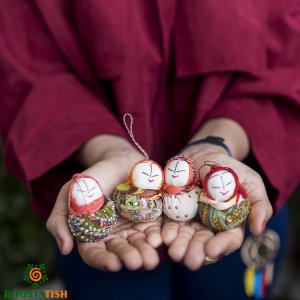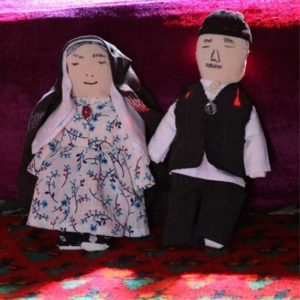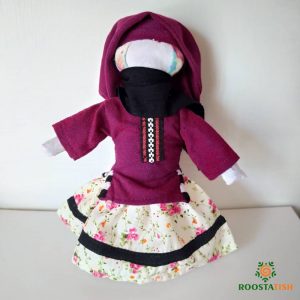Iranian Folk Dolls
Native dolls; Dolls that keep our culture alive. Dolls have always been our companions.
The date of the creation of the first doll goes back to the first years of the presence of humans on this earth. The first dolls were made using wood, mud, stone, etc. In ancient Rome and Greece, when girls grew up and reached an age where they no longer needed dolls, they were offered to the goddesses.
The history of dolls in Iran goes back to years before the arrival of Islam. But there is not much information about these dolls and toys. These dolls were delicate sculptures that looked like humans, and birds, which were made of clay, wood, and stone.
Dolls are usually made of cloth and wood. Today, the making of dolls has become more widespread and more diverse tools are used to make them.
Native dolls are dolls that keep the culture, history and customs of a region alive. These dolls are made by people from different regions and each of them have stories which they carry in their hearts. Native dolls are made with the hands of women, girls, men and boys of the village where they were born. Native dolls can be considered as cultural ambassadors of each region, ambassadors that arise from the heart of that region and travel to other regions to convey a special message.

Each of these dolls is the narrator of their own story and legend, culture, customs, atmosphere of their society.
There are about 2500 traditional native dolls in Iran, each of which is made according to the customs and culture of each region.
While sewing these dolls, rural women hum their own poems and lullabies and by sewing these dolls. It’s as if the toys and dolls are infused with their special culture since the very beginning.
Native Persian dolls, the intangible heritage of our land
Intangible cultural heritage refers to cultural products and processes that have been left over time and from past generations. In Iran, 16 works of our customs, performing arts, skills, knowledge and culture have been registered as intangible heritage. Native dolls are also part of this heritage.
So far, 15 native dolls have been registered as intangible national heritage, and explanations about each of them are provided below.
Dotuk dolls:
This doll, which is made in Tajmir village located in South Khorasan, was registered as one of the intangible national heritage in 2013. Dotuk doll is made of cloth, wood and other available ornaments. Dotuk is a symbol of a Baloch nomadic woman. A woman in an embroidered dress and a colorful scarf. This doll was used as a symbol of rain in the distant past. (You can click here to buy this doll) In the rest of this article, we will introduce some native Iranian dolls.

Types of Iranian native dolls
Dehtuluk doll:
Dehtuluk doll or Dekhtuluk is the name of a native doll in Hormozgan region. Dehtulok means little girl in the local dialect, and the women and mothers of Shib Daraz and Burke Khalaf villages remember learning how to make these dolls from their mothers. These dolls are made by wrapping several colors of fabric around a cotton ball.

Leily Bazbazak doll:
Lily Bazbazak doll belongs to three provinces of Khorestan, Chaharmahal, Bakhtiari and Fars and is known by three different names in each of these three provinces. Leily, Leily Dasti, are some of the different names of this doll. This doll is known as the happiest native Iranian doll, because it dances in the hands of its owners by means of movable joints and threads attached to its hands.

Arusu doll: This doll is handmade by the women of Shahrbabak city and is made with the simplest materials. This doll is about 120 years old.

Bibi Keg Doll:
Bibi Keg may not be just a doll but a symbol of a religious belief. This doll, which is in the category of ritual dolls, is made by the Zoroastrians of Yazd. 30cm Bibi Keg wears traditional Zoroastrian clothing and is not made for play and entertainment.

Native dolls are usually narrators of stories and legends told by the people of a region. In the following, we mention some of these dolls, each of which was made to keep a legend alive:
Golnar doll:
Golnar doll, which is sewn by the women artists of Sarmran. This doll is the narrator of the legend of Golnar, a girl who is in love. (Click to buy the Gulnar doll. ) This doll is sewn according to the love story of Gulnar and Bahman and is a reminder of the beautiful love of these two Kermanj youths. Golnaar is also available as earrings and necklaces which you can buy here!

Khadijeh doll: Khadijeh doll is sewn in memory of the lasting love of Khadijeh and Siamand. This doll is made in Sarmaran village of Esfrain. A village full of stories and beautiful native dolls. (Click to buy Khadijeh doll.)
Khadijeh is also available as earrings and necklaces which you can buy here!
Sometimes native dolls have a mission beyond keeping stories and legends alive. They are made to preserve a species and make us more aware of some rare and endangered animal species. Among these, the Caspian seal doll can be considered as a clear example of this type of dolls.
Dolls that we recognize even without faces
Dolls usually have human or animal faces. Sometimes these faces are made natural and sometimes abstract. But in some provinces of the country, dolls are made which are known as faceless dolls. The makers of these dolls believe that the doll maker should not leave any of his appearance characteristics in the doll he makes. Aroosk is one of the examples of faceless dolls.

How to keep native dolls alive?
The answer to this question is very simple. These dolls, which have been passed down from generation to generation, must continue to exist. This continuation of life requires attention and capital. A capital that will be sometimes as material capital and sometimes as spiritual capital. Keeping these dolls alive will lead to keeping the culture and rituals of our ancestors alive. Therefore, by supporting rural women and helping them in their livelihood and encouraging them to make and supply these dolls, we can play a significant role in achieving this goal. Also, by giving these dolls as a gift to children, in addition to familiarizing them with the clothes, language and culture of different ethnic groups in Iran, it will also contribute significantly to the preservation and continuation of this native art.
click here to see our main page of handmade Iranian Folk dolls
